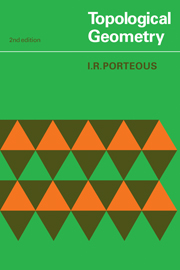Book contents
- Frontmatter
- Contents
- FOREWORD
- CHAPTER 0 GUIDE
- CHAPTER 1 MAPS
- CHAPTER 2 REAL AND COMPLEX NUMBERS
- CHAPTER 3 LINEAR SPACES
- CHAPTER 4 AFFINE SPACES
- CHAPTER 5 QUOTIENT STRUCTURES
- CHAPTER 6 FINITE-DIMENSIONAL SPACES
- CHAPTER 7 DETERMINANTS
- CHAPTER 8 DIRECT SUM
- CHAPTER 9 ORTHOGONAL SPACES
- CHAPTER 10 QUATERNIONS
- CHAPTER 11 CORRELATIONS
- CHAPTER 12 QUADRIC GRASSMANNIANS
- CHAPTER 13 CLIFFORD ALGEBRAS
- CHAPTER 14 THE CAYLEY ALGEBRA
- CHAPTER 15 NORMED LINEAR SPACES
- CHAPTER 16 TOPOLOGICAL SPACES
- CHAPTER 17 TOPOLOGICAL GROUPS AND MANIFOLDS
- CHAPTER 18 AFFINE APPROXIMATION
- CHAPTER 19 THE INVERSE FUNCTION THEOREM
- CHAPTER 20 SMOOTH MANIFOLDS
- CHAPTER 21 TRIALITY
- BIBLIOGRAPHY
- LIST OF SYMBOLS
- INDEX
CHAPTER 6 - FINITE-DIMENSIONAL SPACES
Published online by Cambridge University Press: 06 January 2010
- Frontmatter
- Contents
- FOREWORD
- CHAPTER 0 GUIDE
- CHAPTER 1 MAPS
- CHAPTER 2 REAL AND COMPLEX NUMBERS
- CHAPTER 3 LINEAR SPACES
- CHAPTER 4 AFFINE SPACES
- CHAPTER 5 QUOTIENT STRUCTURES
- CHAPTER 6 FINITE-DIMENSIONAL SPACES
- CHAPTER 7 DETERMINANTS
- CHAPTER 8 DIRECT SUM
- CHAPTER 9 ORTHOGONAL SPACES
- CHAPTER 10 QUATERNIONS
- CHAPTER 11 CORRELATIONS
- CHAPTER 12 QUADRIC GRASSMANNIANS
- CHAPTER 13 CLIFFORD ALGEBRAS
- CHAPTER 14 THE CAYLEY ALGEBRA
- CHAPTER 15 NORMED LINEAR SPACES
- CHAPTER 16 TOPOLOGICAL SPACES
- CHAPTER 17 TOPOLOGICAL GROUPS AND MANIFOLDS
- CHAPTER 18 AFFINE APPROXIMATION
- CHAPTER 19 THE INVERSE FUNCTION THEOREM
- CHAPTER 20 SMOOTH MANIFOLDS
- CHAPTER 21 TRIALITY
- BIBLIOGRAPHY
- LIST OF SYMBOLS
- INDEX
Summary
A finite-dimensional linear space over a commutative field K is a linear space over K that is isomorphic to Kn, for some finite number n. For example, any linear space isomorphic to R2 is finite-dimensional. Among the many corollaries of the main theorem of the chapter, Theorem 6.12, is Corollary 6.13 which states that, for any finite m, n the K-linear spaces Km and Kn are isomorphic if, and only if, m = n. It is therefore meaningful to say that a K-linear space isomorphic to Kn has dimension n or is n-dimensionaly, and, in particular, to say that a real linear space isomorphic to R2 is two-dimensional.
The theory of finite-dimensional linear spaces is in some ways simpler than the theory of linear spaces in general. For example, if X and Y are linear spaces each isomorphic to Kn, then a linear map t : X → Y is injective if, and only if, it is surjective (Cor. 6.33). Therefore, to prove that t is an isomorphism it is necessary only to verify that X and Y have the same dimension and that t is injective. Any finite-dimensional linear space has the same dimension as its dual space and may be identified with the dual of its dual (Exercise 6.44), this being the origin of the term ‘dual’ space.
We begin with a discussion of linear dependence and independence.
- Type
- Chapter
- Information
- Topological Geometry , pp. 100 - 115Publisher: Cambridge University PressPrint publication year: 1981



